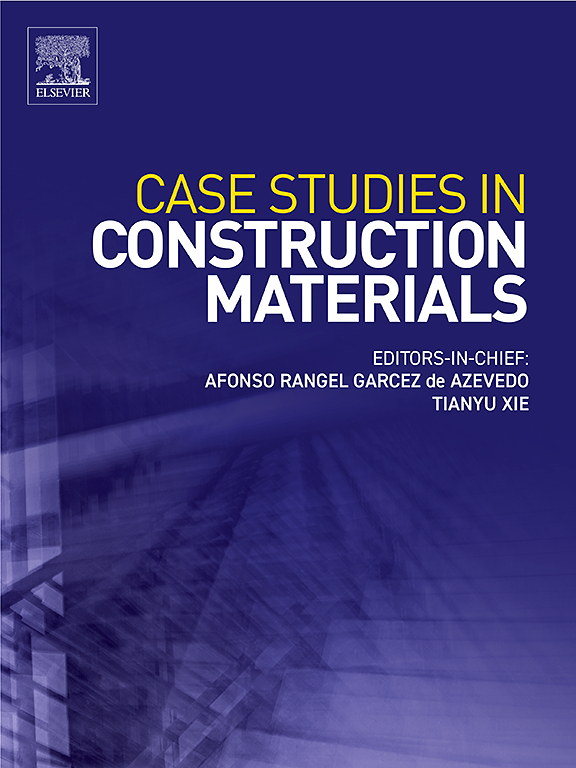Effects of different cementitious materials and accelerators on the flexural and compressive behaviors of SUHPC
IF 6.6
2区 工程技术
Q1 CONSTRUCTION & BUILDING TECHNOLOGY
引用次数: 0
Abstract
The combination of various cementitious materials can effectively mitigate early-age cracking and flowability issues in concrete that arise from the use of accelerators during the spraying process of sprayed ultra-high-performance concrete (SUHPC). Flexural and compressive strengths serve as critical indicators for evaluating the mechanical performance of SUHPC. This study investigates the effects of various types of cementitious materials, including Portland cement, calcium aluminate cement (CAC), and gypsum (CaSO₄·2H₂O, abbreviated as C$), as well as alkali-free accelerators, on the flexural and compressive properties of SUHPC. The results show that partial replacement of Portland cement with CAC alone leads to a significant reduction in flexural and compressive strength, with the greatest decrease observed at a CAC dosage of 30 %. In contrast, in a ternary binder system incorporating both CAC and C$, increasing the C$ content from 0 to 15 wt% enhances the flexural and compressive strengths, reaching maximum values of 21.5 MPa and 123.7 MPa, respectively. The incorporation of CAC negatively impacts the flexural and compressive properties of SUHPC. However, the incorporation of C$ in the ternary binder system effectively offsets the adverse effects of CAC, leading to improvements in toughness and energy absorption capacity. While alkali-free accelerators enhance early-age strength, such admixtures tend to impair long-term mechanical performance. This degradation can be mitigated through the strategic combination of multiple cementitious components.
不同胶凝材料和促进剂对SUHPC弯曲和压缩性能的影响
多种胶凝材料的组合可以有效地缓解喷射超高性能混凝土(SUHPC)在喷射过程中由于使用促进剂而产生的早期开裂和混凝土的流动性问题。抗弯强度和抗压强度是评价SUHPC力学性能的重要指标。本研究考察了不同类型的胶凝材料,包括波特兰水泥、铝酸钙水泥(CAC)和石膏(CaSO₄·2H₂O,简称C$)以及无碱促进剂对SUHPC弯曲和压缩性能的影响。结果表明,单独用CAC部分替代波特兰水泥可显著降低水泥的抗折强度和抗压强度,当CAC掺量为30% %时,降低幅度最大。相比之下,在含有CAC和C$的三元粘结剂体系中,将C$的含量从0增加到15 wt%,可以提高抗弯强度和抗压强度,分别达到最大值21.5 MPa和123.7 MPa。CAC的掺入对SUHPC的弯曲和压缩性能有负面影响。然而,在三元粘结剂体系中加入C$有效地抵消了CAC的不利影响,从而提高了韧性和吸能能力。虽然无碱促进剂提高了早期强度,但这种外加剂往往会损害长期机械性能。这种降解可以通过多种胶凝成分的战略性组合来缓解。
本文章由计算机程序翻译,如有差异,请以英文原文为准。
求助全文
约1分钟内获得全文
求助全文
来源期刊

Case Studies in Construction Materials
Multiple-
CiteScore
7.60
自引率
19.40%
发文量
842
审稿时长
63 days
期刊介绍:
Case Studies in Construction Materials provides a forum for the rapid publication of short, structured Case Studies on construction materials. In addition, the journal also publishes related Short Communications, Full length research article and Comprehensive review papers (by invitation).
The journal will provide an essential compendium of case studies for practicing engineers, designers, researchers and other practitioners who are interested in all aspects construction materials. The journal will publish new and novel case studies, but will also provide a forum for the publication of high quality descriptions of classic construction material problems and solutions.
 求助内容:
求助内容: 应助结果提醒方式:
应助结果提醒方式:


